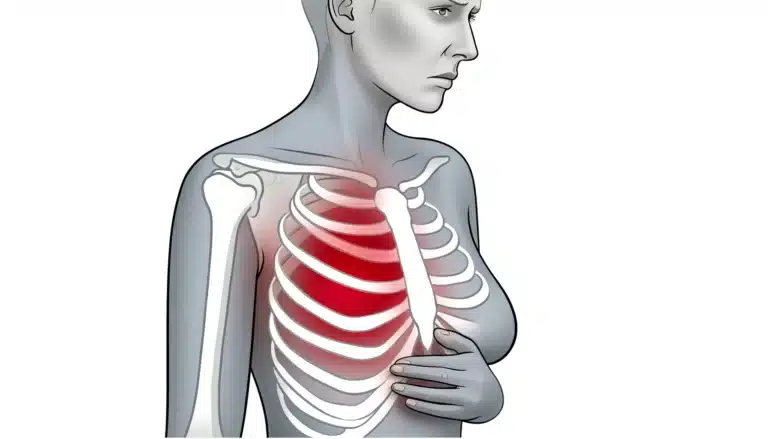Table of Contents

Costochondritis, often known as chest wall pain, can cause substantial chest pain, especially in women. It is defined by inflammation of the cartilage that joins the ribs to the sternum (breastbone), which causes sharp, agonizing, or pressure-like pain in the chest.
Recognizing the exact pain regions linked with costochondritis and distinguishing it from other causes of chest pain is critical for successful management and treatment. This article discusses the distinguishing characteristics of costochondritis in women, how to distinguish it from other causes of chest pain, suitable pain management strategies, and when to seek medical attention.
Understanding Costochondritis Pain Areas in Women
Costochondritis causes pain in the upper chest, usually on the left side, but it can affect either side or both. The pain may spread to the back, abdomen, or arms, mimicking cardiac issues. Because of its proximity to the breast area, women may mistake the pain for breast pain. The main areas affected are:
- The costosternal junctions (where the ribs and sternum meet)
- Costochondral junctions (where the ribs connect to the cartilage)
- Upper ribs (usually the second to fifth ribs).
Twisting, deep breathing, and physical activity, as well as pressure on the affected areas, might worsen the pain.
Differentiating between Costochondritis and Other Chest Pains
Costochondritis must be distinguished from other causes of chest pain, such as cardiac disorders, gastrointestinal troubles, or musculoskeletal problems, due to the possible severity of these conditions. Here are some pointers to help you differentiate costochondritis:
- Costochondritis pain is typically limited to the costosternal, costochondral, and upper rib areas and can be triggered by pressing on these locations.
- Pain Exacerbation: Movements involving the upper body, coughing, or deep breathing might aggravate the pain, which is less probable with cardiac-related chest pain.
- Unlike heart-related chest pain, costochondritis rarely causes systemic symptoms such as nausea, dizziness, or sweating.
Managing Costochondritis Pain
When experiencing chest pain from costochondritis, consider the following steps for relief:
1. Rest and Avoid Aggravating Activities: Avoid activities that aggravate your pain, such as hard lifting or high-impact exercises.
2. Heat and Cold Therapy: Using heat packs or cold compresses on the affected area can help relieve pain and inflammation.
3. Pain Relief Medications: Ibuprofen and other over-the-counter nonsteroidal anti-inflammatory medicines (NSAIDs) can help with swelling and discomfort. However, always contact with a healthcare provider before beginning any medicine.
4. Gentle Stretching: Light stretching exercises, particularly those for the chest and upper body, can help relieve stress and pain.
When to Seek Medical Help?
While costochondritis is normally not a serious ailment, it is important to seek medical assistance in the following situations:
- Pain that is Persistent and Worsening: Persistent or worsening pain occurs when the pain does not improve with home care or worsens with time.
- Difficulty Breathing: If you have shortness of breath or significant pain while breathing.
- Signs Of Infection: Infection signs include redness, swelling, pus, and fever at the painful locations.
- Ruling out Other Disorders: Because symptoms might mimic more serious disorders such as heart disease, a comprehensive evaluation by a healthcare professional is recommended to rule out other possible causes.
Conclusion
Costochondritis can be an unpleasant condition, especially when it mimics more serious chest problems. Understanding the precise pain sites and characteristics of women’s costochondritis, as well as learning how to manage the discomfort and when to seek medical attention, can help women handle this illness more effectively. Always err on the side of caution and seek medical attention if you’re unsure about your symptoms or if they continue despite home treatment efforts.
Frequently Asked Questions
Q: Can costochondritis develop into something more serious?
A: Costochondritis is a benign disorder that does not cause major problems. However, it is critical to confirm that the chest pain is not caused by a more serious underlying problem.
Q: How long does costochondritis last?
A: The duration of costochondritis varies; some patients recover in weeks, while others may endure symptoms for months or more. A healthcare provider should evaluate persistent symptoms.
Q: Are there any exercises to avoid if I have costochondritis?
A: High-impact sports or exercises that put a strain on the chest, such as weightlifting or rigorous upper-body workouts, should be avoided until the pain goes away.
Q: Can stress aggravate costochondritis?
A: Stress does not cause costochondritis, although it can worsen pain and suffering from muscular strain. Stress management approaches may be useful in alleviating some symptoms.
Remember that, while costochondritis is usually not a dangerous condition, your health and well-being come first. Consulting a healthcare professional for a proper diagnosis and treatment plan is always the best option.
If you need expert advice or have questions and concerns about chest pain or any other heart-related problems, consider giving us a call at +65 6235 5300.
Written by: Dr Michael MacDonald MB ChB, BSc (Hons), MRCP (UK), MD (Research), FESC (Europe). Dr MacDonald was trained in the UK and is a senior Consultant Cardiologist.

